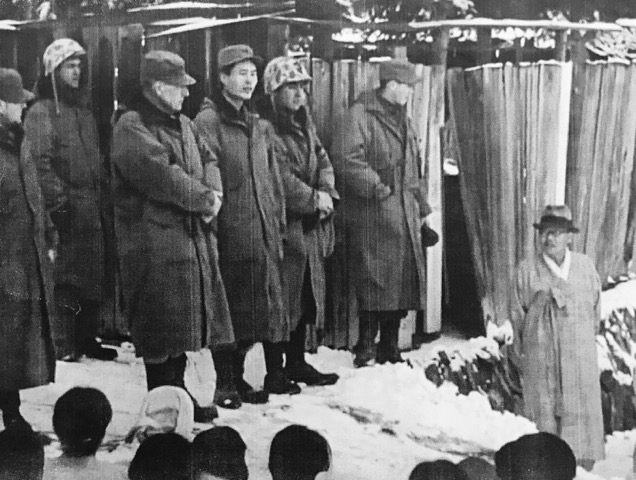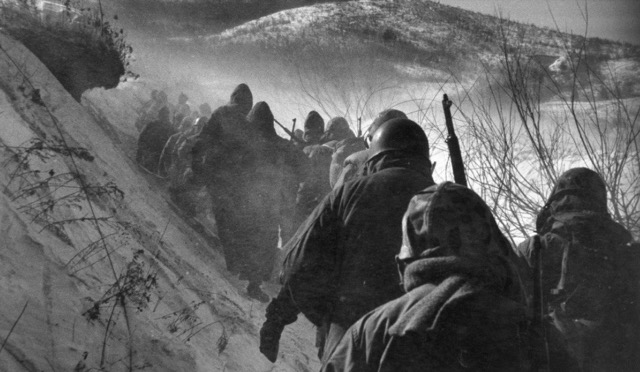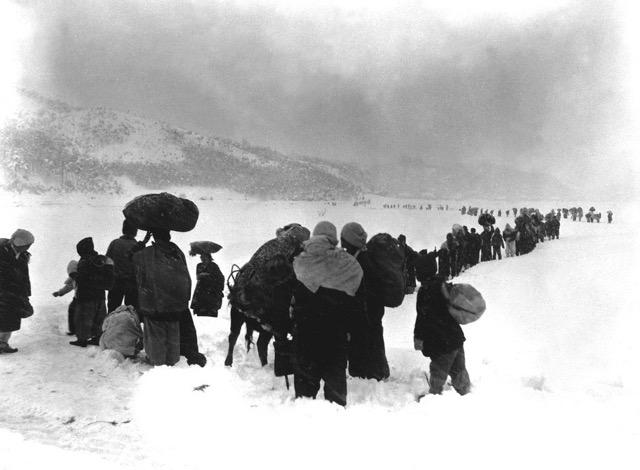An Eternal Brotherhood

On a cold, starless night deep in the snow-covered mountains of North Korea, John Lee, a Korean interpreter with 1st Marine Division, watched as about twenty people cautiously entered a small building.
Worried that the suspicious-looking North Korean civilians might be communist sympathizers plotting to infiltrate American units at Chosin, he made his way silently towards the wood-framed structure. Coming to a window, he peered inside.
What he saw shocked him.
Men and women, sitting on a dirt floor and holding weathered Bibles and hymnbooks, were praying. Seconds later, they began to sing.
“I saw in their faces a torment . . . they had suffered spiritually under Communist domination, denied to worship God, and tortured for their beliefs,” Lee says in Martin Russ' best-selling book Breakout. “I saw many crying . . . and I knelt down in the snow and prayed for them."
He would remember the scene for the rest of his life . . .
Serving With The Marines
Three months earlier, in August 1950, South Korean Army Lieutenant Yi Jong-yun, or "John Lee" as the Americans would call him, had been assigned to the US Marine Corps as a liaison officer and interpreter. The twenty-one-year-old Korean, who had learned English from an American missionary, was eager to impress the hard-charging Marines.
Over the next six months, Lt. Lee, by all accounts, would do exactly that - and more.
Climbing up crater-filled hills on the Pusan Perimeter; hitting the beach at Inchon; and dodging bullets and shrapnel during house-to-house fighting in Seoul, Lee proved his worth. But it was during the Battle of Chosin that the young Korean interpreter made a name for himself.
The Battle Of Chosin
At Chosin Reservoir, the site of one of the most epic engagements in Marine Corps history, nearly 30,000 Americans fought against 120,000 Chinese. Throughout the battle, Lee would “serve as an inspiration to all who observed him.”
On one occasion, Lt. Lee, in total disregard for his own safety, led a group of North Korean civilians into a barren, snow-covered field to collect supplies that had been airdropped by the US only minutes earlier. With enemy machine gun and mortar fire erupting around him, the lieutenant charged into the drop zone and helped drag the much-needed food, ammo, and medical crates to friendly lines, away from the approaching Chinese.

Marines making their way out of the Chosin Reservoir in early December 1950. John Lee was with them every step of the way. (Photo credit: David Douglas Duncan)
Days later, during the 1st Marine Division’s breakout to the sea, Lt. Lee, in charge of a provisional police force responsible for guarding prisoners of war, courageously “led his men in mopping up hostile remnants along the route.”
For his “cool courage under fire, aggressive leadership, and conscientious efforts," he was awarded the Legion of Merit for bravery and “outstanding services to the Government of the United States.”
Reminiscing years later about his time with the Marines, Lee said, "We formed an eternal brotherhood at Chosin."
The Road to Hungnam
To this day, John still talks about the North Korean refugees who were fleeing from the Chinese. According to Lee, many of the civilians, like those he saw praying that fateful night at Chosin, never made it to Hungnam, the port city where 105,000 UN troops, including the Marines, were evacuated.
“The road from Hagaru to Hungnam was too treacherous,” Lee told me recently. “But some made it,” he added. “They never gave up following us.”

North Korean civilians walking towards Hungnam in December 1950. (Photo credit: USMC Archives)
Postscript
John Lee spent the remainder of the Korean War serving with the Marines. He later moved to America, graduated from Yale Law School, and worked as a New York attorney. In 1960, he became an American citizen and in 1967 was hired as legal advisor to US Forces, Korea. His story had come full circle.
"The reason I became a US citizen," Lee said, "is because of my experiences with the Marines during the Korean War."
Lee is a founding member of the Chosin Few, the elite band of brothers who fought at the Reservoir. In his interview for Breakout he said, “When the Chosin Few have their reunions, I am there to hold the hands of my brothers once more.”
“The Marines are the toughest fighters in the world,” he proudly told me.
John, who turns ninety today, and his wife, Gil-Ja, divide their time between Seoul and Hernando, Florida. They have two children and four grandchildren.
Happy 90th Birthday, John! Thank you for your service and dedication to the US Marine Corps, the Republic of Korea, and the United States.
Semper Fidelis!
Top picture: Lt. Lee (center) interpreting for a US Marine colonel (on left) as he addresses citizens of Hagaru-ri in November 1950. (photo credit: John Lee)






Oh, wow!
John Lee is my mother’s uncle (my grandmother’s brother), who she remembers fondly. I found this lovely tribute while I was on the phone with her discussing a family member who was just accepted into Yale. She mentioned that her uncle graduated from Yale Law, and said that I might be able to find his name somewhere online. Boy howdy, was she right! She and I were thrilled to have found this story and the beautiful photos; thank you so, so much for sharing them!
Great to hear from you, Michelle, and apologies for the delay in responding.
John is a great friend and I’m honored to know him. He’s done so much as a Chosin Marine. I’m hoping to see him again soon in Seoul.
Glad you and your mom found your way to this story. Please send my regards to your mother as well.
Thanks again for writing.
Chosin Reservoir 1/1/1. Inchon to July 1951.
Former Treasurer, The Chosin Few.
2012-2015
Semper Fi
Thank you for reading the blog and commenting, and thank you for your service to country and Corps.
I’m sure you probably know John Lee. He’s a great guy, and I was honored to have met him here in Korea.
Semper Fi!